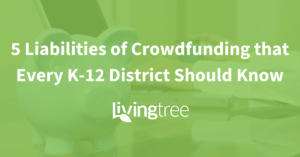School districts across the country are faced with a new challenge when it comes to funding: managing the liabilities of crowdfunding (online fundraising). With the number of school teachers spending money out of pocket for classroom projects, and the after-school clubs and teams in need of additional funding, there is no question about why we’ve seen a boom in online fundraising on sites like DonorsChoose, GoFundMe, SnapRaise, etc. While the act of crowdfunding is beneficial for both the organizer and the district, the crowdfunding sites being used have little to no coordination with the school districts themselves, creating a number of potential legal, financial, and reputational liabilities.
In a recent article by Education Week, administrators described today’s crowdfunding process as “decentralized,” and the Tennessee Comptroller stated that the “sites are problematic for school districts because of lack of adequate controls.” He’s not the first one to say this either. A growing number of state auditors, district superintendents, business officers and district attorneys and accountants recognize this exposure. They have made it clear that crowdfunding presents real problems for existing management systems, and that the practice must meet district legal requirements.
School districts assume all liabilities related to crowdfunding as soon as someone within a school or district uses their position to raise funds. State laws delegate responsibility to school districts for activities in schools in this area including the academic and other purposes of those activities and accounting for use of funds including procurement. In addition, federal laws govern student privacy and students with special needs including compliance with written requests on the webpage viewed by prospective donors. Districts who have no processes or policies place themselves in legal jeopardy. Below we explore many of the liabilities that school districts should be aware of.
What Crowdfunding Liabilities Should School Districts What For?
FERPA (Student Confidentiality) Violations
Federal laws govern student privacy and prevent student information from being disclosed. Images from the school, or taken at the school by an employee or agent, and used in a crowdfunding campaign might violate student privacy. This scenario can happen all too easily with photographs taken in the classroom, especially when combined with written information in the campaign story, pitch, and description. In some cases, this type of posting needs to be reviewed by a district’s safety and security division for the protection of the students and the organizer.
IDEA Violations
State and federal laws under IDEA incorporate student privacy and the protections covered under FERPA. When images are used and combined with campaign descriptions, organizers must take caution in listing specific student characteristics such as a student’s disability. In certain cases where the successful completion of the fundraiser would significantly change a student’s special education experience or Individualized Education Program (IEP), IDEA may require that a school provides the student’s family with prior written notice for those changes. Additionally, because states receive additional funding for students with IEPs, IDEA requires that any items covered under a student’s IEP be funded by the school district. Because school districts are legally obligated to provide resources to help students achieve their IEP, a teacher’s campaign may draw federal scrutiny upon the district as a potential violation of IDEA if it is implied that the school was failing to supply the resources covered in an IEP.
Personal Collection of Funds
Funds should never be routed through the personal bank accounts of any district members. Donations should always be donated to and collected by the school or district. Funds that are collected within personal bank accounts open up accountability issues, and also create tax issues for both the organizer and the donor. When donations are made to and collected by an individual, that person is susceptible to taxes, and the donations are not tax-deductible for the donor.
Accountability of Funds
Funds that are managed by the individual organizer opens opportunities for fraud and may violate certain policies or laws. In some states, there is only a certain amount of time that an organizer has available to deposit any donations with the district treasurer. The treasurer could be held liable in any situations of unaccounted funds.
Ownership
A common question upon completion of any fundraising campaign is who owns the funds or items donated – is it the organizer who set up the campaign and worked to collect donations or the district to which the organizer belongs to? Issues can arise for districts without clear policies outlining the ownership of donated funds and items if teachers or staff members leave their school or district with the assumption that those items belong to them.
Inventory
Many policies and laws state that any items donated must be tagged and logged into district inventory within a certain time frame. Items that are donated without coordination of the district are subject to being misused, lost, or stolen.
Financial Reports
Donations must be controlled and reported on by the school district. These financial reports are crucial for audits and reporting out charitable donations made to the district.
Appropriateness of Requests
The funds or items requested should be appropriate, have the right intentions, and align with the district’s mission or vision. An inappropriate request may create PR issues for a school or district.
Perceptions of a School or District
Every campaign reflects in some way on the school, the district and the students. A campaign for resources that a school is responsible for supplying, or a negatively written campaign description may paint the school or district in a poor manner and create PR issues.
Use of School and/or District Name and Logo
Organizing parties always need express permission to use the school or district name and/or logo to solicit funds. Any use of a school or district’s name, or a school or district’s logo within a campaign automatically creates liability for the district. School districts become responsible for any consequences associated with the campaigns, which is why the district must always be involved in the process and give permission for use of those items.
Compatibility with Curriculum and Standards
All items purchased or donated must meet policy requirements and be compatible with the curriculum and standards of the school and district. This is especially true for fundraisers involving technology. Additional costs of necessary software and licenses required to install on new technology should also be taken into account. Funds or items donated that are incompatible with the curriculum or district standards may result in a waste of funds that donors can take issue with.
Campaigns for Emergencies and Crises
Campaigns created for individuals who are undergoing an emergency or crisis put the affected individual and the donor at risk. Campaigns like these create the perception that donations are going to a “school,” and are therefore tax deductible. Unfortunately, because these funds are going to an individual, donations are not tax deductible and potentially subject to taxes on the individual’s side. Districts and Education Foundations who oversee these types of fundraisers can actually set up proper processes and procedures to collect donations, and also ensure that the affected individuals receive support.
Equity
Districts must be aware of potential equity issues between classrooms, teams, or even schools when fundraising. If campaigns are not clear about where the money is going, what it is being used for, or who it is benefiting, parents and donors may make assumptions and take issue.
Other Considerations for School Districts:
Goal Amounts and Deadlines
On some websites, if campaigns do not meet their set funding goal by a specific deadline, the money can be lost (either returned to the donor or rerouted to a completely different campaign on the site). This is both valuable funding and time lost which can cause donor frustration. Typically a site with flexible goals and deadlines, or that allows the recipient to keep the money is best.
Transaction Fees
Reviewing the fees built in and kept by the website or program is important, and usually something that the Financial Services department needs to review to determine if the percentage fee is appropriate. Donors may take issue if the fees aren’t transparent. Some websites will request an additional “tip” or donation, or even take up to 50% of the funds raised as a fee.
Campaign Marketing and Donor Management
In every case, the district should have the abilities to easily market fundraisers within their district, as well as “own” and manage their donor information. Websites without district controls will typically take ownership of donor information and use it for the remarketing of other campaigns on their site (typically not from your district). Owning the marketing and donor management allows districts to fundraise more effectively over time.
How can districts support crowdfunding and protect their staff, schools, and donors?
Be aware of your current situation
Conduct an internal review to understand what current policies, procedures and guidelines you have in place. Review what crowdfunding sites are available and what is being used in your district. Try and determine what campaigns have been funded or completed in your district and whether your current policies, guidelines, and procedures were followed.
Establish an Approval Process
An important practice to note when it comes to crowdfunding is that districts need an internal review/approval process for every online campaign because only those with a vested interest in the district can properly assess whether a campaign is compliant with all district policies, as well as state and federal laws. Even crowdfunding sites that claim to “vet” campaigns before they are launched won’t catch everything pertinent to a particular district, let alone all state and federal laws. Sites like DonorsChoose have been cited to have campaigns that posed some potentially significant legal and reputational issues for the associated schools and districts, even after going through their site’s screening process. At the end of the day, you have a mix of educators, parent organizations, boosters, teams and clubs who are launching campaigns in the best interest of their students but aren’t always aware of the legal liabilities or the political activities of the school district, which is why districts must safeguard everyone. This type of internal review process ensures that every publicly posted campaign is in the best interest of the district, is in compliance with policies and laws, and is in line with what a district is doing politically.
Find and endorse a platform that is right for your district
In order to protect your users, donors, and the district itself, your online fundrasiing platform should allow for your district to approve campaigns before they go live. A platform like Livingtree Give has an automated process that allows tiered layers of approval for every campaign that districts can customize. The fundraising platform should also be all-inclusive to your entire district, meaning that teachers, parent organizations, teams, clubs, boosters, and even your education foundation have the ability to use it. The platform should also have trackable and auditable systems in place so that every dollar donated is recorded and easily dispersed to the appropriate schools and groups. The platform you choose should also provide thorough and easy to use reporting, so that not only can you easily disperse funds, but you can report out every donation at the end of the year. Finally, the platform should be owned by your district, meaning that your district is in control of who has access, how it’s set up, and all of the associated marketing and donors who contribute to your campaigns.
Bonus info: Get the School District Crowdfunding Considerations Guide for a real example of the risks that school districts are facing and the 7 areas that administrators need to consider.
A platform such as Livingtree Give contains all of the features listed above and fills the needs of K-12 school districts by providing oversight and management of every online fundraiser in the district. Unlike other platforms, Livingtree Give was developed in coordination with district finance teams, making it the only platform specifically built for K-12 school districts.
If you’d like more information about how Livingtree Give can help your district manage online fundraising, visit the webpage here.
Looking for additional guidelines to help you evaluate crowdfunding sites and platforms?





Pingback: How to Make Crowdfunding Work in Your School District (A Step-By-Step Guide) - Livingtree
Pingback: Crowdfunding Policy Guidance & Best Practice for School Districts - Livingtree
Pingback: What You Need to Know About School Crowdfunding - Livingtree